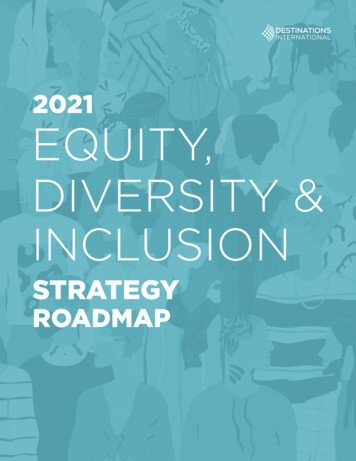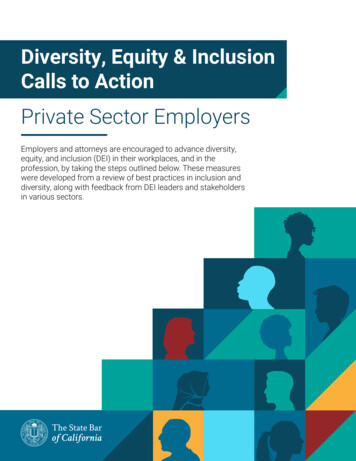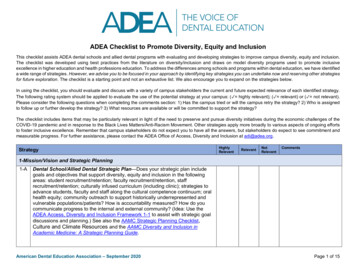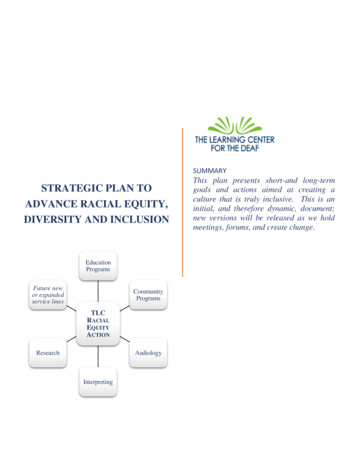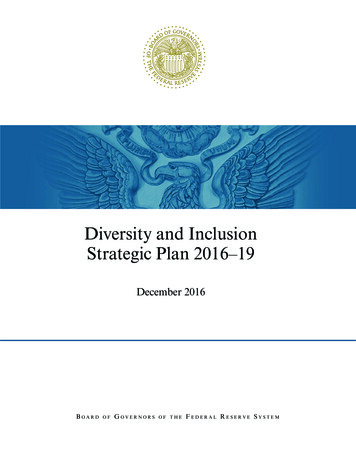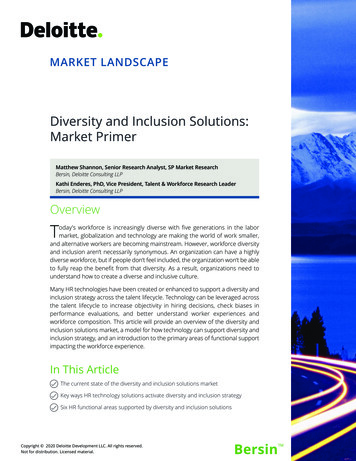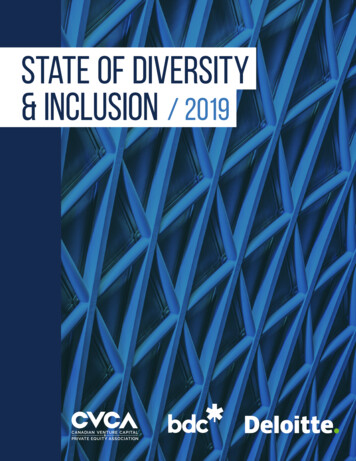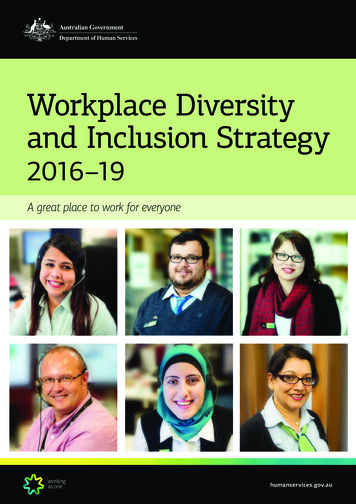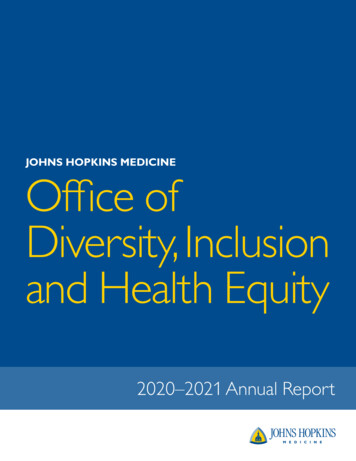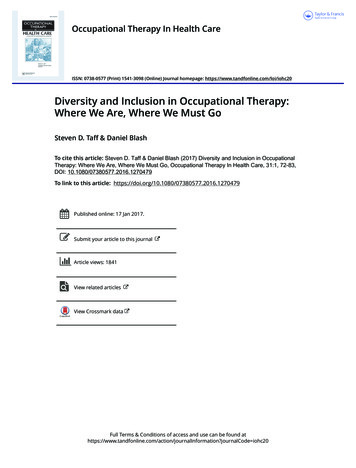
Transcription
Occupational Therapy In Health CareISSN: 0738-0577 (Print) 1541-3098 (Online) Journal homepage: https://www.tandfonline.com/loi/iohc20Diversity and Inclusion in Occupational Therapy:Where We Are, Where We Must GoSteven D. Taff & Daniel BlashTo cite this article: Steven D. Taff & Daniel Blash (2017) Diversity and Inclusion in OccupationalTherapy: Where We Are, Where We Must Go, Occupational Therapy In Health Care, 31:1, 72-83,DOI: 10.1080/07380577.2016.1270479To link to this article: shed online: 17 Jan 2017.Submit your article to this journalArticle views: 1841View related articlesView Crossmark dataFull Terms & Conditions of access and use can be found ation?journalCode iohc20
OCCUPATIONAL THERAPY IN HEALTH CARE , VOL. , NO. , – http://dx.doi.org/ . / . . Diversity and Inclusion in Occupational Therapy: Where WeAre, Where We Must GoSteven D. Taffand Daniel BlashWashington University School of Medicine, St. Louis, MO, USAABSTRACTARTICLE HISTORYDiversity is a fundamental element of the AOTA Centennial Visionand a critical aspect for the visibility, growth, and sustainabilityof the occupational therapy profession. In this article, the authorssuggest that, while the profession has been aware of the needfor a diverse workforce and has taken steps to increase diversityand cultural competency, a more structured, comprehensive, andaction-oriented approach must be considered to address an issuewhich impacts professional roles and client engagement, satisfaction, and well-being. Informed by the value-added and mutualaccommodation models of cultural diversity, the authors providespecific strategies and actions which promote diversity and inclusion at the personal, institutional/organizational, and professionallevels.Received March Accepted December KEYWORDSCultural diversity; education;students; professionalpractice; organization andadministrationIntroductionThe American Occupational Therapy Association (AOTA) Centennial Vision statesthat “We envision that occupational therapy is a powerful, widely recognized,science-driven, and evidence-based profession with a globally-connected anddiverse workforce meeting society’s occupational needs” (American OccupationalTherapy Association [AOTA], 2007). Diversity and inclusion are not simply elements of a greater professional vision; they are also antecedents for supporting occupational therapy’s growth and visibility internationally. This is echoed in Vision2025, which conceptually builds upon the Centennial Vision: “Occupational therapy maximizes health, well-being, and quality of life for all people, populations, andcommunities through effective solutions that facilitate participation in everyday living” (AOTA, 2016). Vision 2025 addresses the larger social context in which diversityand inclusion are paramount, namely within community and population health.Conversations regarding diversity are not new to occupational therapy (Grady,1995; Black, 2002; Abreu & Peloquin, 2004; Clark, 2013). However, these conversations need enhanced translation into action plans to build and support a morediverse workforce. The broad aim of this paper is to explore the issue of diversityCONTACT Steven D. Tafftaffs@wustl.eduWashington University School of Medicine, Program in OccupationalTherapy, Forest Park Avenue, Campus Box , St. Louis, MO, , USA. Taylor & Francis Group, LLC
OCCUPATIONAL THERAPY IN HEALTH CARE73and inclusion in occupational therapy and offer strategies necessary to achieve thegoal of building a diverse workforce in the profession. Throughout the paper, wereiterate the need for occupational therapy to recognize diversity and inclusionas concepts having significant implications for the sustainability and prominenceof the profession. Diversity and inclusion have often been cast in an ethical lightand focused on the individual client encounter, but less frequently in an applied,professionally centered manner. In order to achieve a more diverse workforce,the profession needs to create and support institutionally accepted systems whichpromote diversity and inclusion along a continuum from student recruiting toorganizational re-structuring. We set out to accomplish our objectives by first framing the issue, which includes defining what we mean when we discuss “diversity”and “inclusion” and providing a reminder of why diversity and inclusion are sovery crucial to the livelihood of the profession. We follow this with a brief synopsison the current state of diversity and inclusion in Occupational Therapy- “wherewe are” in terms of creating a diverse workforce. Next, we briefly describe fourmodels of diversity which are commonly found in organizations and institutions.We then conclude with examples and a case study which utilize the value-addedand mutual accommodation models of diversity to guide practical ideas for implementing change in occupational therapy at the person, program/institutional, andprofessional levels—“where we must go”.Diversity and inclusion definedThe term “diversity” has been historically operationalized in myriad ways, frequently in reference to methods of erasing discrimination in organizations and institutions. In the context of higher education, it has also been synonymous with overallstudent body composition (Milem, Chang, & Antonio, 2005). However, for the purposes of this paper and subsequent strategies, we suggest these somewhat limitedconceptions of the term are inadequate. Ross (2011) provides more breadth, usingthe term diversity to describe “the broad field of issues related to difference as wellas issues relating to how people of different kinds are participating in a particularorganization or society” (p.37). The spirit of the present discussion aligns more congruently with The American Association of Colleges and Universities (AAC& U)report, Making Diversity Work on Campus (Milem, Chang, & Antonio, 2005) definition of diversity as “engagement across racial and ethnic lines comprised of a broadand varied set of activities and initiatives” (p. 4).Society is increasingly viewing diversity from a wider perspective, which nowincludes gender, disability, religious beliefs, and sexual orientation in addition torace and ethnicity. In occupational therapy practice, all aspects of diversity canimpact the quality and outcome of services, while certain ones will be more criticaldepending upon each unique context. While fully supporting the need to approachdiversity with a wide lens, in this paper we narrow our focus to race, as race is acategory that historically has significantly impacted social status (Goffman, 1959;Rajaman & Bockrath, 2014). Other studies have supported this assertion, indicating
74S. D. TAFF AND D. BLASHthat racial interactions have more impact than non-racial interactions (Bowman,2010). Despite our focus on race as a factor, other social identities and relatedfactors (such as language) can easily be addressed within the actions we suggest.Inclusion is a related concept, one that has received neither the media nor thescholarly attention that has accompanied diversity. Inclusion can be thought of asfostering an environment where uniqueness of beliefs, backgrounds, talents, capabilities, and ways of living are welcomed and leveraged for maximum engagement(including decision-making) by members of the learning or working community(Bleich, MacWilliams, & Schmidt, 2015). It is paramount that efforts to includeall people are encouraged by senior leaders, on-going and intentional. Ross (2011)views inclusion as a “function of how fully involved people are in the structures oftheir organizations Inclusion is a function of connection” (p. 38). Adding dimensions of diversity- simply having a presence- is not enough. People must feel as ifthey have opportunities for meaningful and sincere connections with others whichallow them to be valued members of their communities (Milem, Chang, & Antonio,2005; Museus, 2014). Inclusion does not occur automatically via proximity. It mustbe built, nurtured and sustained as part of organizational or professional culture.To persist and succeed in educational (or workplace) settings, people need to feelpart of the daily atmosphere, not as “guests in someone else’s house” (Turner, 2015,p. 345).Vision of a diverse workforce and value to the professionWhat would a “diverse workforce” look like in occupational therapy? The profession is currently comprised mostly of practitioners, educators, and leaders whoare white women. Rather than suggest specific desired percentages, we prefer touse broad brush strokes and advocate that every profession benefits from diversitybroadly conceived-race, ethnicity, gender, religion, sexual orientation, disability—where each person has the opportunity to offer their own unique, context-focusedcontribution. Far beyond the obvious ethical and humanist reasons for increasing diversity, the literature is replete with evidence that a more diverse studentbody or workforce produces creative and competitive advantages while also enhancing a sense of belonging. In social, academic, or professional groups, diversityenhances creativity and competitiveness and positively impacts organizational culture (Surowiecki, 2004; Chavez & Weisinger, 2008). Specific to the context of highereducation, research has repeatedly concluded that increasing the diversity of a campus “leads to a broader collection of thoughts, ideas, and opinions and a widerange of perspectives on a particular issue” (Milem, Chang, & Antonio, 2005, p.7).Chang (2001) examined the relationship between racial prejudice and a variety ofeducational experiences. He found that lower levels of prejudice promote criticalthinking and increases adaptability, key characteristics which enhance academic(and professional) success. Finally, Hurtado et al. (2003) found that individuals whoare educated in more diverse environments are more likely to work and live in ethnically diverse settings post-graduation.
OCCUPATIONAL THERAPY IN HEALTH CARE75In terms of clinical practice, therapists will be called upon to deliver moreservices in community and population environments where a public health orientation will be critical. Social determinants of health and health disparities disproportionately impact underrepresented populations. Three distinct realities underpin the need for having a diverse workforce: (a) Under-represented minority healthprofessionals disproportionately serve minority and other medically underservedpopulations; (b) minority patients tend to receive better interpersonal care frompractitioners of their own race or ethnicity; and (c) non-English speaking patientsexperience better interpersonal care, greater medical comprehension, and greaterlikelihood of keeping follow-up appointments when they see a language-concordantpractitioner, particularly in mental health care (Sullivan Commission on Diversityin the Healthcare Workforce, 2004). These findings suggest that increased diversity within health care will potentially lead to improved public health by increasing opportunities for minority patients to see practitioners with whom they sharea common race, ethnicity or language. Race, ethnicity, and language concordance,which are associated with better patient-practitioner relationships and communication, may increase patients’ likelihood of receiving and accepting appropriate care. That being said, it is equally important to avoid creating a situationwhere, for example, only African-American occupational therapists treat AfricanAmerican clients. The point here is that, ideally, all occupational therapists should betrained to deliver quality services for all clients. While it is likely that occupationaltherapists have more frequent contact with diverse clients than other careers, it isessential to remember that diversity and inclusion are issues which, as rooted ininstitutional structures, are very relevant to society as a whole, and not solely thetherapeutic province of professions which serve people with difficulties living theirdaily lives. Cultural awareness and competence with individual client care are essential, but it is those spaces where occupational therapy and social structures meet—advocacy, policy, perception, climate—are where we must focus our efforts. In anincreasingly dynamic and competitive healthcare environment, occupational therapy must leverage every opportunity to position itself as a profession which can assisteveryone in meeting their occupational needs. In coming back to the CentennialVision, the goals of being widely recognized, globally-connected, and diverse areall related—diversity and inclusion can help facilitate wider recognition and globalconnections.Where we are: The diversity and inclusion landscape in 2016Leaders in occupational therapy have been aware of the needs for a diverse workforce and the value of diversity for our clients and colleagues for quite some time.Scholars have brought the topic to the profession’s attention on various occasionsover the past three decades (Grady, 1995; Black, 2002; Abreu & Peloquin, 2004;Clark, 2013). Since the early nineties, the profession has intermittently placed diversity on its public agenda and provided resources to support efforts such as ad hoccommittees for diversity, the Multicultural Affairs Program (which existed from
76S. D. TAFF AND D. BLASH1991 to1998) and the theme of the 1995 Annual Conference, “Diversity: Our Journey Together” (Black, 2002). Professional publications and offices of the nationalassociation have sought to address diversity in a variety of ways. The OccupationalTherapy Practice Framework stresses culture as a significant factor for consideration in evaluation and intervention (American Occupational Therapy Association,2014a), educational standards cite related factors as key learning content (AmericanOccupational Therapy Association, 2011), and the Code of Ethics supports effortsto serve underrepresented and marginalized populations (American OccupationalTherapy Association, 2015). The American Occupational Therapy Association hasmade a commitment to non-discrimination and inclusion (American OccupationalTherapy Association, 2014b) and supported the formation and activities of numerous multicultural networking groups (e.g. the Multicultural, Diversity, and Inclusion (MDI) Network, which includes the National Black Occupational TherapyCaucus and Network of Hispanic Practitioners, among others). In addition, morerecent advocacy groups such as the Coalition of Occupational Therapy Advocatesfor Diversity (COTAD) are being supported nationally by the Association. Muchof the occupational therapy literature related to diversity in the profession calls forpractitioners to be client-centered, culturally responsive, and to develop culturalcompetence when serving diverse clients (Munoz, 2007; Balcazar et al, 2009). Forexample, the American Occupational Therapy Association (2013) Frequently AskedQuestions sheet regarding diversity concentrates on terminology such as culturalsensitivity and cultural competence in addition to offering informative resources topractitioners. All the above activities are encouraging signs of the genuine commitment the Association has towards increasing awareness of diversity issues impactingthe profession (see Table 1).Certainly, progress has been made. However, notwithstanding better visibility ofthe issue and valuable initiatives aimed at increasing and celebrating diversity in theprofession, data continues to indicate that occupational therapy remains a mostlywhite profession. From 2010-2012, 87% of occupational therapists were White, 5%were African-American, and 4% were Hispanic (U.S. Department of Health andHuman Services, 2014). In 2013, 86% (OTD), 82% (MSOT, and 78% (OTA) ofstudents were White. Only 4% (OTD), 5% (MSOT), and 10% (OTA) wereAfrican-American and 4% (OTD), 7% (MSOT), and 11% (OTA) were Hispanic(American Occupational Therapy Association, 2014c). There have been, at best,modest increases in the numbers of underrepresented minority students enrolled. Inaddition, the latest AOTA Faculty Workforce Survey (2010) indicates similar metrics. Total faculty ethnicity (OTD, MSOT, and OTA) was 89% White, 3% AfricanAmerican, and 2% Hispanic. This remains an issue of significant concern for theprofession, higher education, the clients we serve, and society at large.Where we must go: Guideposts for actionDiversity, and to a much lesser extent, inclusion, are recognized as issues that occupational therapy must address. However, discussions surrounding these issues must
OCCUPATIONAL THERAPY IN HEALTH CARE77Table . Diversity and inclusion action matrix.Approach/ContextValue-AddedMutual AccommodationPersonal Membership in multiculturalorganizations/groups Cultural caring and competence aspractitioner Cultural awareness activities Community service in underservedareas Critical self-appraisal “Acts of Care” from peers and facultyProgram/Institution Faculty/staff/student awarenesstraining Add diversity & inclusion issues tocurricular content Encourage SOTA groups to planactivities to increase awareness andreflection Faculty and peer mentoringprograms Faculty development on creatinginclusive and “identity safe”classrooms “Talking Circles” with faculty andstudents to discuss issues ofidentities, bias, and cultureProfessional Create community-building activitiesand programs to intentionallyconnect underrepresented students Intentional student recruitmentefforts for underrepresented groups Centennial Vision content Support advocacy groups (e.g.COTAD) ACOTE standards reflecting culture OTPF (culture) Diverse workforce initiatives Multicultural networking groups (e.g.MDI, NBOTC) Diversity Ad Hoc Committee OT commitment tonon-discrimination and inclusion Critique of profession, institutions,society Research/publication on diversity &inclusion issues Make diversity & inclusion explicitelements of strategic plans to ensureaccountability Implement reporting systems fordiscrimination and bias Scholarships and graduateassistantships to add dimensions ofdiversity Implement learning climate surveysto collect evaluation data Contain costs by reducing credithours and time to degree Create “Future OT Scholars” programsfor underrepresentedundergraduates interested inhealthcare Create Chief Diversity Officer role andinfrastructure Increase scope of practice to fullypromote a public health/healthdisparities approach Create a standing Diversity &Inclusion Committee Support part-time, weekend, andevening options for degree programs Include implicit bias, power, privilege,and allyship in ACOTE standards Publish an official position statementon diversity & inclusiontranslate into action and be facilitated by a shift in strategic approach, one thatnudges professionals beyond the necessary skills of awareness and culturally competent care. The literature describes four cultural models of diversity which illustrate how diversity has typically been addressed in most organizations and institutions of higher education (Plaut, 2002): sameness, common identity, value-added,and mutual accommodation. Among these four models, a rough boundary canbe drawn between the sameness and common identity models—which place morefocus on assimilation—and the value-added and mutual accommodation modelswhich bring forward and affirm dimensions of diversity.In the sameness model “people are people” and diversity is viewed in a relativelysuperficial manner. The sameness model presumes that the experiences and goals
78S. D. TAFF AND D. BLASHof all people in a given population (or society) are similar. In the United States (andmost Western/European societies), this model is exemplified in the acceptance ofthe assumption that “all men are created equal.” This motto implies that the playing field is level and that individual behavior and hard work are the determinantsfor success. Race and ethnicity are seen as irrelevant. The decategorization strategyof the sameness model has been the prevalent approach towards diversity, particularly in the United States (Plaut, 2002). The common identity model acknowledgesthat differences among groups do exist, but should be minimized through creatingencompassing identities (Plaut, 2002). This model rests on the idea that differencesare diminished because all group members ascribe to common values and goals—the “teamwork” perspective. The strategy employed within the common identitymodel is to recategorize “group boundaries from us and them to we” (Plaut, 2002, p.380). While the relevance of teamwork cannot be ignored, it is equally as importantthat we do not lose sight of the importance of individual differences. Emphasizing“we” while not appreciating “I” may result in feelings of individual disconnectednessand loss of value.The value-added model suggests that we acknowledge differences in people andgroups positively as sources of strength which add significant value to organizations,institutions, and professions (Plaut, 2002). This model shares the common identityacceptance of substantial group differences, but differs in that it does not supportrecategorization. The mutual accommodation model also agrees that differencesbetween people and groups exist, but that these differences should be accommodated regardless of value-added perceptions. This model legitimizes different experiences and norms, while advocating for changes which create respectful and safeclimates where all cultures feel valued and connected. Organizations and institutions should consider the benefits of accommodating cultural differences instead ofexpecting assimilation (Plaut, 2002).We propose that the value-added and, particularly, the mutual accommodation models offer the most potential for actionable change. We appreciate thatmany worthwhile initiatives supporting diversity and inclusion are already occurring in occupational therapy, most fitting conceptually within the value-added context. However, our contention is that the profession needs to be more focusedon a mutual accommodation context which creates critical consciousness and thefullest accountability for producing impactful results. Although existing along thesame continuum, the prominent distinction between the valued-added and mutualaccommodation perspectives lies in moving from conceptual support and awarenessto emotional agency and risk. Building a culture of mutual accommodation requiresa more explicit focus on doing, stepping outside comfort zones, and making systemicchanges in policy and procedures. We also suggest that the mutual accommodationmodel best supports building and sustaining inclusive workplaces and learning environments, an area where most organizations, institutions, and professions need toplace more focus. We have integrated the two models to form a matrix for diversity and inclusion that guides practical action in multiple levels and contexts (seeTable 1).
OCCUPATIONAL THERAPY IN HEALTH CARE79The strategies presented in Table 1 offer actionable ways in which the Centennial Vision words “diverse workforce” can be transformed into actions, policies, and accountable goals. Such strategies can occur on the personal, organizational/institutional, or professional levels. For example, at the personal level, Turner(2015) describes “acts of care” which can have “life-changing results and greatly contribute to building an environment that nurtures human and community potential”(p.352). These acts of kindness include pointing out career options, supplying contacts to build networks, and offering advice on processes and feedback on research orpractice. Recognizing and confronting one’s own implicit biases and advocating forequal transparency from local and professional organizations and policies are additional ways to approach action from a personal standpoint. Organizations and institutions can advance change through faculty and peer mentoring programs or including diversity and inclusion explicitly in strategic planning. Many institutions ofhigher education use diversity and inclusion training to address organizational climate. Such trainings are often characterized by awareness-raising activities with nosubstantial follow-up to dig deeper into the underlying causes. However, the mutualaccommodation model is best exemplified when training moves beyond awarenessto meaningful dialogue across differences, honest critique and plans for change.Case Study: A model for implementationThe following case study provides one example of how an approach influenced bythe mutual accommodation model has been implemented. A College of HealthSciences at Metropolitan University sought to gain a deeper understanding of issuesinvolving diversity and inclusion. They believed to best serve the community in thebroadest sense, it was important to first look inside to ensure that the people whostudy, work and train on their campus felt welcomed, respected and nurtured. Toget a better understanding, faculty, staff, postdocs, fellows, residents and studentswere invited in an anonymous diversity engagement survey. Leaders agreed that thesurvey could help them assess where they were in terms of diversity and inclusionand how they could improve at the College. There was strong participation in thesurvey, and the results indicate that race, gender and other factors play a significantrole in how we perceive our connection to the College. The results provided a baseline for measuring future progress and showed that under-represented minorities(African-American and Hispanic respondents) were less positive than Caucasianparticipants, particularly on questions regarding mutual respect, trust in management, and diversity within the school. Asian respondents were as positive as orslightly more positive than Caucasian survey-takers regarding most issues. Womenwere generally as positive as men in their responses. However, women were lesspositive than men on questions related to trust in management, and whether peopleare recognized equally based on their contributions. Younger employees were morepositive in their responses than older employees, and employees here less thanfive years were more positive than those who had worked here longer. Studentswere generally more positive than those in other groups. The College’s goal was tomove the diversity and inclusion conversation beyond awareness into action and
80S. D. TAFF AND D. BLASHinstitutional climate change. Based upon the survey results, the College institutedseveral initiatives aimed at improving the campus culture for all College of HealthSciences stakeholders with an emphasis on the under-represented minorities andwomen. Four diversity and inclusion trainings were developed and made available,as a pilot program, to all College of Health Sciences community members. Thetraining began with a basic awareness to give College stakeholders a rudimentaryunderstanding of campus demographics, historical challenges between groups andto highlight best practices for team work and creating an environment of mutualrespect. Subsequent training introduced the concept of unconscious bias and provided tips for mitigating its impact on campus. The third training centered on wayto speak up and address bias without projecting blame or guilt. The final trainingincluded carousel brainstorming, planning, and assigning accountabilities for facilitating a warmer, more diverse and inclusive environment. The four iterations ofdiversity and inclusion training laid the foundation for an on-going open dialogueseries where self and institutional appraisal was encouraged. The open dialogueseries made room for deep and meaningful engagement across differences. Thetraining and subsequent dialogue series received positive evaluations by participants. The College of Health Science’s leaders ultimately submitted a proposal forUniversity-wide adoption of the mutual accommodation training model. Collegeof Health Science faculty and staff volunteered to serve as advisors to the Universitythroughout the implementation of the training model.This case study describes an intentional effort to address diversity and inclusionwhich was part of a larger University-wide focus to build and sustain a positive andwelcoming learning and working environment.Finally, at the professional level, the mutual accommodation approach can beillustrated through a variety of actions. For example, occupational therapy organizations (both state and national) can provide resources to support advocacygroups and create a chief diversity officer role and associated infrastructure. TheAccreditation Council for Occupational Therapy Education could consider infusingeducational standards with diversity-related content such as unconscious bias, professional power differentials, and strategies for being an ally for underrepresentedgroups.Barriers to changeWhile supporting the need for a change in strategic approach, we acknowledgethat there are barriers, not the least of which are the implicit but rather entrenchedbiases of personal experience, attitudes, and institutional policies and practices.More specific and common barriers also exist. Diversity and inclusion efforts oftenfall short when they are not articulated as a central part of the institution’s missionstatement and fundamentally rooted in day-to-day operations. An individual orinstitutional mindset that views diversity and inclusion as a threat to excellence orotherwise mutually exclusive can often undermine good intentions and programsdesigned to improve organizational or campus climate. Gaining access to stakeholders is often challenging due to high demands on their time. The time factor can
OCCUPATIONAL THERAPY IN HEALTH CARE81be especially disruptive if those stakeholders have
Diversity and Inclusion in Occupational Therapy: Where We Are, Where We Must Go Steven D. Taff & Daniel Blash To cite this article: Steven D. Taff & Daniel Blash (2017) Diversity and Inclusion in Occupational Therapy: Where We Are, Where We Must Go, Occupational Therapy In Health Care, 31:1, 72-83, DOI: 10.1080/07380577.2016.1270479


